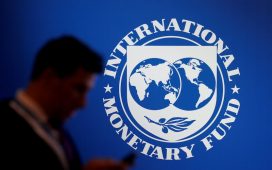Saudi Arabia’s energy minister Prince Abdulaziz bin Salman has claimed to be inspired by former Federal Reserve chair Alan Greenspan, but the central banker he appears to most frequently channel is Mario Draghi.
In seeking to prop up oil markets, the minister appears to be adopting a strategy akin to the pledge of the former European Central Bank president to do “whatever it takes”. The problem for Prince Abdulaziz, after a protracted Opec+ meeting in Vienna over the weekend, is that while the rest of the cartel might share his goal, it does not really share his commitment.
The only production cut coming out of two days of talk will be shouldered by Saudi Arabia alone, which will remove 1mn barrels a day — or about 10 per cent of the kingdom’s current production — from the market next month. And it’s only for a month, albeit with a promise that it could be extended.
The other producers in the 23-member group, which collectively pumps more than 40 per cent of the world’s oil, will keep their production largely as is, with existing curbs only formalised and extended into 2024 — a lifetime away in a volatile market.
Opec+ ministers, under pressure from Prince Abdulaziz, according to delegates, put on a united front after the meeting. The African nations such as Angola, Nigeria and Equatorial Guinea reluctantly accepted their production baselines would be lowered next year but are arguably just playing along. They struggle to hit Opec+ targets even when cuts are in place.
Delegates and advisers made clear after the event that the African nations have little intention of lowering production, as they try to rejuvenate their output after being hard hit during the Covid-19 crash.
That on its own should not matter too much for the oil price. Traders long ago discounted the production targets for countries such as Nigeria and Angola, focusing instead on what they actually produce. But public displays of unity only go so far if everyone suspects they are fighting behind the scenes.
Now, Saudi Arabia has backed itself into cutting production alone — something Prince Abdulaziz once vowed to avoid, indicating he didn’t want any free-riders in the group.
To add to the kingdom’s problems two of Saudi Arabia’s strongest partners in Opec+ — Russia and the UAE — are hardly rushing to join in further cuts.
Russia is broadly seen as pumping what it can given the stresses and strains created by western sanctions and other measures designed to restrict its oil revenue (though not necessarily its exports).
The UAE was the biggest winner from the meeting, receiving approval for a long-sought higher baseline of output and approval to raise production by 200,000 b/d from next year.
“The United Arab Emirates clearly had a good weekend,” said Helima Croft at RBC Capital Markets.
Saudi Arabia is left doing much of the heavy lifting on its own. Traders think Prince Abdulaziz has now created a situation whereby the same short sellers he warned to “watch out” before the meeting can test his resolve each month.
It will be hard for him to add the 1mn b/d back to the market unless the price stabilises north of $85 a barrel, compared with about $75 a barrel before the meeting.
The market reaction so far has been lukewarm, with Brent crude rising only about 1.2 per cent on Monday. It could, of course, slowly grind higher. But the psychology of the market seems untroubled by the prospect of real physical tightness emerging.
There have been warnings all year that the market will tighten substantially in the second half of 2023, but so far traders have largely ignored the bait. A higher oil price would add to fears of recession, inflation or higher interest rates — all of which would depress demand.
Rory Johnston at consultancy Commodity Context said traders remained “sceptical of the producer group’s capacity to manage this market”.
Next year will also see a US presidential election, which suggests that while the White House has barely reacted to the latest Opec+ move, traders know the Biden administration will be laser-focused on keeping pump prices in check.
Many wonder if it is time for Opec+ to take a breath after three production cuts in eight months. Prince Abdulaziz spoke yesterday about Opec+ acting in a “precautionary” manner and emphasised the need for “transparency” in the market. The latter comment raised eyebrows in the oil industry, well aware of the barring of several prominent Opec reporters from the event.
But what might be considered “precautionary” can also end up looking like excessive tinkering to others. Even “whatever it takes” loses its power if its overused.
david.sheppard@ft.com





